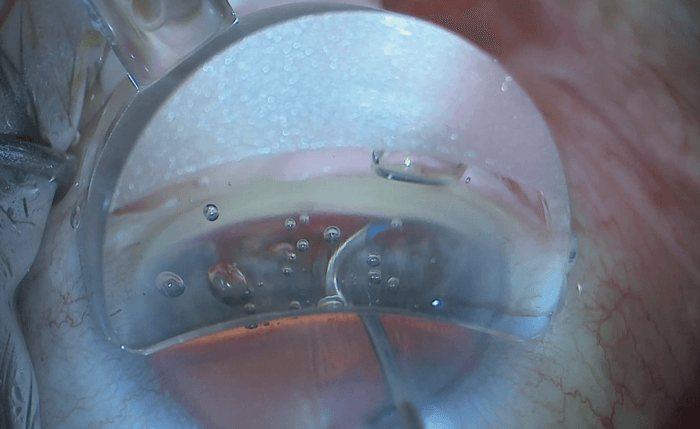
Since introducing the OMNI Surgical System system in 2022, ophthalmologists at Southampton General Hospital’s glaucoma and cataract surgery practice have performed over 100 procedures with the implant-free MIGS device. Francesco Stringa – a specialist glaucoma consultant at Southampton General Hospital since 2020 – says that the results so far have shown great promise.
12-month prospective multicenter clinical data shows that over 84 percent of eyes achieved reductions of IOP ≥20% from baseline using the OMNI Surgical System, with 76 percent of eyes achieving an IOP between 6-18 mmHg inclusive (1).
The side effects that have occurred – most commonly, mild hyphema – have been transient, self-limiting and easily managed in the early, postoperative stage with no serious adverse events reported or secondary surgical interventions required.
According to Stringa, one notable advantage of OMNI over other available MIGS interventions is that each step can be performed gradually. Surgeons are not required to place a stent in an exact location at an exact moment; instead, they have time to ensure that the procedure is progressing as planned and get visual and tactile feedback that they are treating the correct structures. In essence, the OMNI system offers a manageable learning curve for surgeons seeking to begin their MIGS journey or expand their existing armamentarium.
To support a favourable outcome with OMNI, Stringa has gathered some pearls of wisdom – not least the need for surgeons to have a clear and unobstructed view of the trabecular meshwork. When engaging the trabecular meshwork with the cannula tip, it is important that the surgeon’s view is perpendicular to the trabecular meshwork because this facilitates the correct entry of the microcatheter into Schlemm’s canal.
When advancing the catheter through Schlemm’s canal, it is important to stabilize the device against the trabecular meshwork as much as possible to avoid any unnecessary trauma. The advance of the catheter should be performed using a steady motion; Ultimately, ensuring the right view, correct positioning, and accurate insertion of the catheter into Schlemm's canal from the outset are imperative for consistently achieving positive outcomes.
As the catheter advances through the canal, there is the slight possibility of encountering what Stringa refers to as a “hard stop” – where the catheter encounters resistance inside the canal. This resistance can usually be attributed to morphological changes in eyes with glaucoma, such as collapsed areas and stenosis. In the case of a hard stop, Stringa advises retracting the catheter by approximately two clock hours which automatically injects viscoelastic from the device to gently expand the canal, allowing the surgeon to smoothly resume the catheter’s advancement.
When asked how to decide between canaloplasty alone or in combination with trabeculotomy, Stringa explains that the stage of glaucoma (and therefore the target pressure) is the primary criterion – and efficacy is a major consideration. Stringa also highlights the potential drawback of overtreating patients with early glaucoma; in this group of patients, canaloplasty without trabeculotomy, could be the treatment of choice as it reduces the intraocular pressure and at the same time spares the anatomy of the trabecular meshwork for future interventions. Where a greater reduction in pressure is needed, combining with trabeculectomy would be the preferred approach. Stringa emphasizes the point that both 180 and 360 degree trabeculectomy with OMNI has an excellent safety profile, making it clear that Sight Sciences’ technology represents a safe and efficacious option for his mild and moderate glaucoma patients.

IMPORTANT PRODUCT INFORMATION:
INDICATIONS FOR USE: The OMNI® Surgical System is indicated for the catheterization and transluminal viscodilation of Schlemm’s canal and the cutting of trabecular meshwork to reduce intraocular pressure in adult patients with open-angle glaucoma. For important safety information including contraindications, warnings, precautions and adverse events, please visit omnisurgical.com
Mr. Stringa is a paid consultant of Sight Sciences
Disclaimer
This information is intended solely for the use of ophthalmic clinicians - Patients should contact their eyecare professional
CE2797
© 2023 Sight Sciences, Inc. 6/23 OM-2936-OUS.v1
References
- MJ Gallardo et al., Canaloplasty and Trabeculotomy Combined with Phacoemulsification for Glaucoma: 12-Month Results of the GEMINI Study, Clin Ophthalmol, 16, 1225 (2022). PMID: 35493971.
